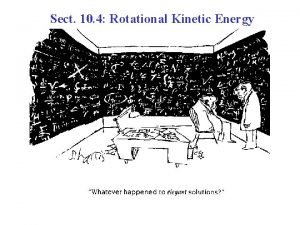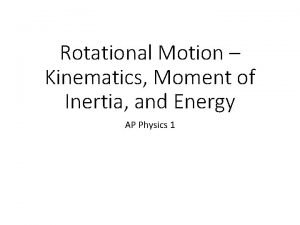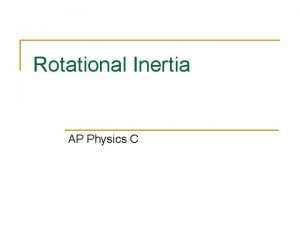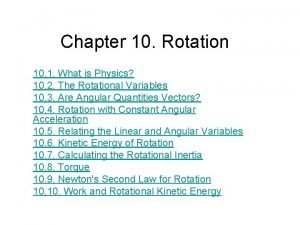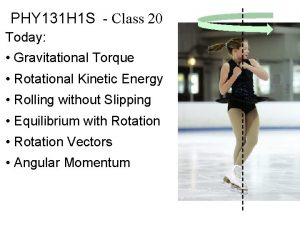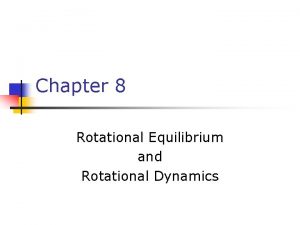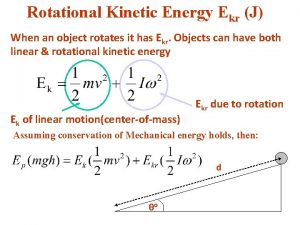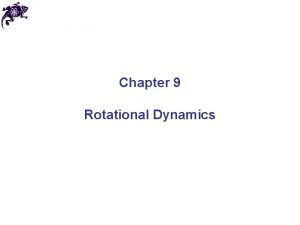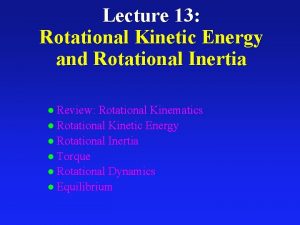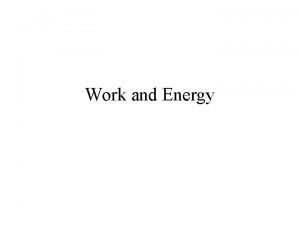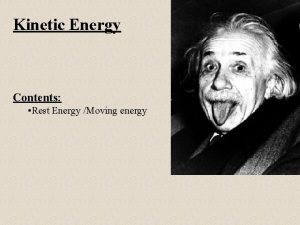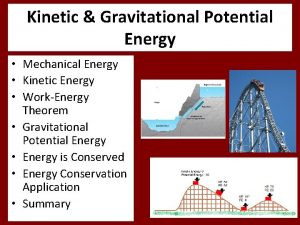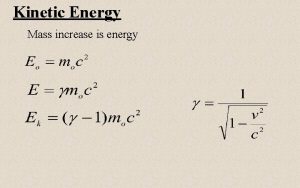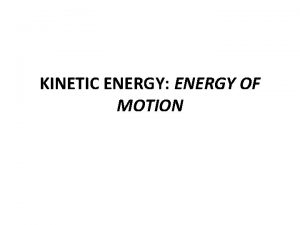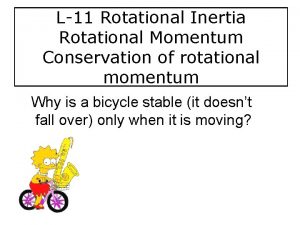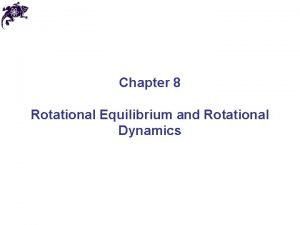p 69 Rotational Kinetic Energy Ekr J When
















- Slides: 16

p 69

Rotational Kinetic Energy Ekr (J) When an object rotates it has Ekr. Objects can have both linear & rotational kinetic energy Ek of linear motion(center-of-mass) Ekr due to rotation Assuming conservation of Mechanical energy holds then: d θ°


d Practical h θ° Set up a ramp, of height h Measure the time for the cylinder to roll down the slope for a distance d Assume no energy lost to friction, find the cylinders • final speed & final kinetic energy Ek • initial gravitational potential energy Ep • final rotational Kinetic energy Ekr • Calculate final angular speed ω • Determine the rotational inertia of the cylinder Are your E values realistic? Errors? Assumptions?

The ring and biscuit wheels have identical mass and radius. Both ramps are identical. Both wheels are released at the same time. Which wheel will reach the bottom of the slope first? Explain your answer Biscuit wheel will reach the bottom of the slope first. ring You cannot achieve a grade to an answer that has a 50: 50 chance of being correct. biscuit • The inertia of the ring wheel is more that of the inertia of the biscuit wheel so the ring wheel is harder to get started. • The biscuit wheel having a lower inertia is easier to accelerate. • Since the biscuit has less rotational inertia then it will also have less Rotational Kinetic Energy at the bottom of the hill compared to the ring (Ekr=1/2 Iw 2) • Since the biscuit has less Ekr it has more Ek – since both start with the same Ep and Ep = Ek + Ekr.

A truck wheel has a mass of 65 kg and a radius of 0. 56 m. It is rolling down a 2. 0 m high slope. The truck wheel gains 540 J of rotational energy by the time it reaches the bottom of the slope. 1. Show the wheel's translational velocity at the bottom of the slope is 4. 8 m s-1. 2. Show the wheels angular velocity is 8. 6 s-1 at the bottom of the slope. 3. Calculate the rotational inertia of the truck wheel. 2 m

1. Show the wheel's translational velocity at the bottom of the slope is 4. 8 ms -1.

2. Show the wheels angular velocity is 8. 6 s-1. 3. Calculate the rotational inertia of the truck wheel.

Say Galileo tested his free fall theory by rolling different diameter solid spheres down a slope, instead of dropping them off a ledge. Prove that his free fall theory is correct. Assume all spheres must be the same, i. e. solid and round. Galileo Galilei


Betty-Sue and Bubba decide to roll different objects down a long sloping, smooth driveway. The driveway can be treated as a ramp (see animation) and it has a 15 degree angle to the horizontal. Their 1 st object is a ball of 438 grams and a diameter of 19. 5 cm that rolls from rest 5. 9 m along the driveway. (a) Calculate the angular displacement of the ball as it rolls down the ramp. radius = = 0. 0975 m = 60. 512… ≈ 61 rad (2 SF) 5. 9 m Applet link 15°

(b) The ball takes 3. 19 s to reach the bottom of the driveway. Calculate the final angular velocity and the angular acceleration of the ball.

(c) Calculate the rotational kinetic energy of the ball at the base of the ramp. (hint: use other energies to find your answer)

(d) What assumption(s) did you make in answering the previous question? Assumption: that all of the gravitational potential energy at the top of the hill was converted to linear kinetic and rotational kinetic energies at the base of the drive. Or: no energy was “lost” to heat or sound as the ball rolled down the drive.

(e) Calculate the rotational inertia of the ball. (f) Calculate the angular momentum of the ball at the base of the ramp.

(g) Later, Bubba lets 2 different masses go at the same time. He chooses a disk and a ring of the same mass and radius. Explain which reaches the bottom of the ramp first and why. • The disk will reach the bottom before the ring. • Since they have the same mass but different mass distribution, they have different rotational inertias while having the same total energy (E P at the top of the hill). • The ring has a larger rotational inertia, I, than the disk, since more of its mass is farther from the centre. • Thus the ring will have a larger portion of its original gravitational potential energy converted into rotational kinetic energy than the disk. • This leaves a small portion of energy for linear kinetic, thus a smaller linear speed for the ring.
 Rotational kinetic energy units
Rotational kinetic energy units Kinetic rotational energy formula
Kinetic rotational energy formula Rotational inertia ap physics 1
Rotational inertia ap physics 1 Rotational kinetic energy units
Rotational kinetic energy units Rotational kinetic energy
Rotational kinetic energy Ekr bad fredeburg
Ekr bad fredeburg Torque right hand rule
Torque right hand rule Rotational equilibrium
Rotational equilibrium Kinetic energy of a spring
Kinetic energy of a spring Gravitational
Gravitational Gravitational potential energy vs kinetic energy
Gravitational potential energy vs kinetic energy Kinetic energy to thermal energy
Kinetic energy to thermal energy Kinetic and potential energy
Kinetic and potential energy Kinetic energy examples
Kinetic energy examples Mechanical energy conservation
Mechanical energy conservation Gravitational potential energy
Gravitational potential energy Conservation of mechanical energy
Conservation of mechanical energy
